

Kialo Edu - The tool to teach critical thinking and rational debate. Triangulated Teaching and Learning with David Anderson. What is Cooperative Learning? Cooperative learning involves more than students working together on a lab or field project.
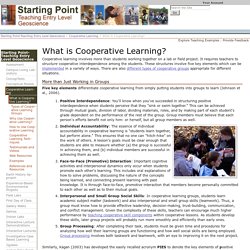
It requires teachers to structure cooperative interdependence among the students. These structures involve five key elements which can be implemented in a variety of ways. Home - Visual Thinking Strategies. How to Use YouTube Video Essays in the Classroom. Like many of you, I've been thinking a lot lately about how we can better prepare students to be thoughtful, responsible, and critical consumers and creators. While I don't have all the answers, I've come to one conclusion: Media-literacy education must deal with YouTube. Ninety-one percent of teens use YouTube. That's 30 percent more than use Snapchat (61 percent), the next closest social media competitor, and even more than use tech we think of as ubiquitous, like Gmail (79 percent).
What's more, YouTube is a unique beast and can't just be tacked on. It has its own celebrities, culture, norms, and memes and has even given rise to the dreaded "YouTube voice. " Why Students Forget—and What You Can Do About It. Teachers have long known that rote memorization can lead to a superficial grasp of material that is quickly forgotten. But new research in the field of neuroscience is starting to shed light on the ways that brains are wired to forget—highlighting the importance of strategies to retain knowledge and make learning stick.
In a recent article published in the journal Neuron, neurobiologists Blake Richards and Paul Frankland challenge the predominant view of memory, which holds that forgetting is a process of loss—the gradual washing away of critical information despite our best efforts to retain it. According to Richards and Frankland, the goal of memory is not just to store information accurately but to “optimize decision-making” in chaotic, quickly changing environments. In this model of cognition, forgetting is an evolutionary strategy, a purposeful process that runs in the background of memory, evaluating and discarding information that doesn’t promote the survival of the species.
Educational Leadership:Questioning for Learning:How to Make Your Questions Essential. They stimulate ongoing thinking and inquiry.

They're arguable, with multiple plausible answers. They raise further questions. They spark discussion and debate. They demand evidence and reasoning because varying answers exist. PERTS : Growth Mindset for 9th Graders. Many students hold debilitating beliefs about their intelligence.
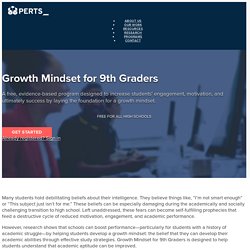
They believe things like, “I’m not smart enough” or “This subject just isn’t for me.” These beliefs can be especially damaging during the academically and socially challenging transition to high school. Left unaddressed, these fears can become self-fulfilling prophecies that feed a destructive cycle of reduced motivation, engagement, and academic performance. P21. Activities that Promote Awareness of What Constitutes Cheating. Although some behaviors are pretty much universally identified as cheating (copying exam answers, for example), we’re not in agreement on everything.
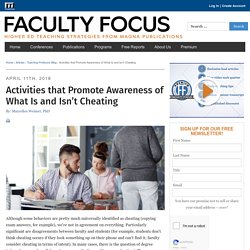
UDL: The UDL Guidelines. Match Minis.
Classroom Management. Working with Parents. Warmups and Starters. Educational Leadership:Questioning for Learning:Five Strategies for Questioning with Intention. Arthur L.
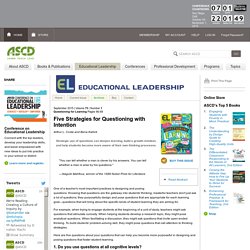
Costa and Bena Kallick "You can tell whether a man is clever by his answers. You can tell whether a man is wise by his questions. " —Naguib Mahfouz, winner of the 1988 Nobel Prize for Literature One of a teacher's most important practices is designing and posing questions. For example, when trying to engage students at the beginning of a unit of study, teachers might ask questions that stimulate curiosity. Here are five questions about your questions that can help you become more purposeful in designing and posing questions that foster student learning. 1.
Bloom's taxonomy (1956) identified various levels of thinking that learners can engage in, from the lowest (remembering) up through understanding, applying, analyzing, evaluating, and creating.
Mindset Kit - Home. Top 20 principles from psychology for teaching and learning. ASCD Express 10.19 - Field Notes: The Day I Ditched Points. Thinking & Questioning. Teaching via Concepts. Flipped Teaching. Blended Learning. Project Based Learning. Inquiry-based learning. Express 10.07 - Field Notes: Three Ways I Changed What My Grades Say. Field Notes Three Ways I Changed What My Grades Say Nancy DeRego "I got a 3 out of 5 on that journal assignment.
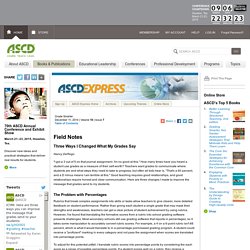
I'm no good at this. " How many times have you heard a student use grades as a measure of their self-worth? The Problem with Percentages Rubrics that break complex assignments into skills or tasks allow teachers to give clearer, more detailed feedback on student performance. To adjust for this potential pitfall, I translate rubric scores into percentage points by considering the each score as a range of possible percentage points. Stop Single Grading A single grade for a complex assignment can hide the true range of student achievement.
Report Lateness Separately Often, grades are made even murkier when measures of compliance—appearance and punctuality, for example—are hidden in an overall achievement grade. ASCD Express, Vol. 10, No. 7.
Express 9.15 - Supporting Effort by Pairing Rubrics with Checklists. Supporting Effort by Pairing Rubrics with Checklists Cynthia Kube In my position as a gifted resource teacher, I often see students struggle with the planning required for a challenging task.
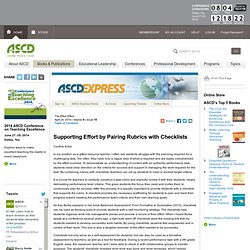
Digital Portfolios. High Impact Instruction. SBG Videos: SBG 101 - Standards-Based Grading Videos. Educational Leadership:Getting Students to Mastery:The Value of a Pointless Education. Jay C.
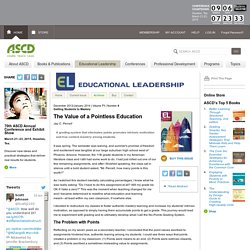
Percell I decided to restructure my classes to foster authentic mastery learning and increase my students' intrinsic motivation, as opposed to simply having them accumulate points to get a grade. This journey would lead me to experiment with grading and to ultimately develop what I call the No-Points Grading System. The Problem with Points Reflecting on my seven years as a secondary teacher, I concluded that the point values ascribed to assignments hindered true, authentic leaning among my students. 8 Strategies for Teaching Academic Language.
"Change your language and you change your thoughts.
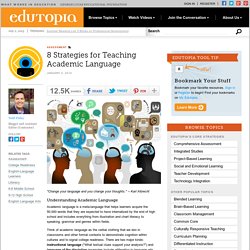
" -- Karl Albrecht Understanding Academic Language Academic language is a meta-language that helps learners acquire the 50,000 words that they are expected to have internalized by the end of high school and includes everything from illustration and chart literacy to speaking, grammar and genres within fields. Think of academic language as the verbal clothing that we don in classrooms and other formal contexts to demonstrate cognition within cultures and to signal college readiness. There are two major kinds: instructional language ("What textual clues support your analysis? ") and language of the discipline (examples include alliteration in language arts, axioms in math, class struggle in social studies and atoms in science).
Updated Padagogy Wheel Tackles The Problem Of Motivation In Education. One of the biggest problems at the core of education is motivation. That’s according to the newest iteration of the popular Padagogy Wheel (pad for iPad instead of ‘ped’agogy) we showcased a couple weeks ago. Allan Carrington spent what must be counless hours thinking, revising, and refining the wheel you see below which is now at version 3.0.
Be sure to click here to view version 2.0 of the wheel and click here to view version 1.0. What’s New In The Padagogy Wheel Version 3.0 The new version tackles a major question that is lurking in the back of everyone’s mind. MET Project.